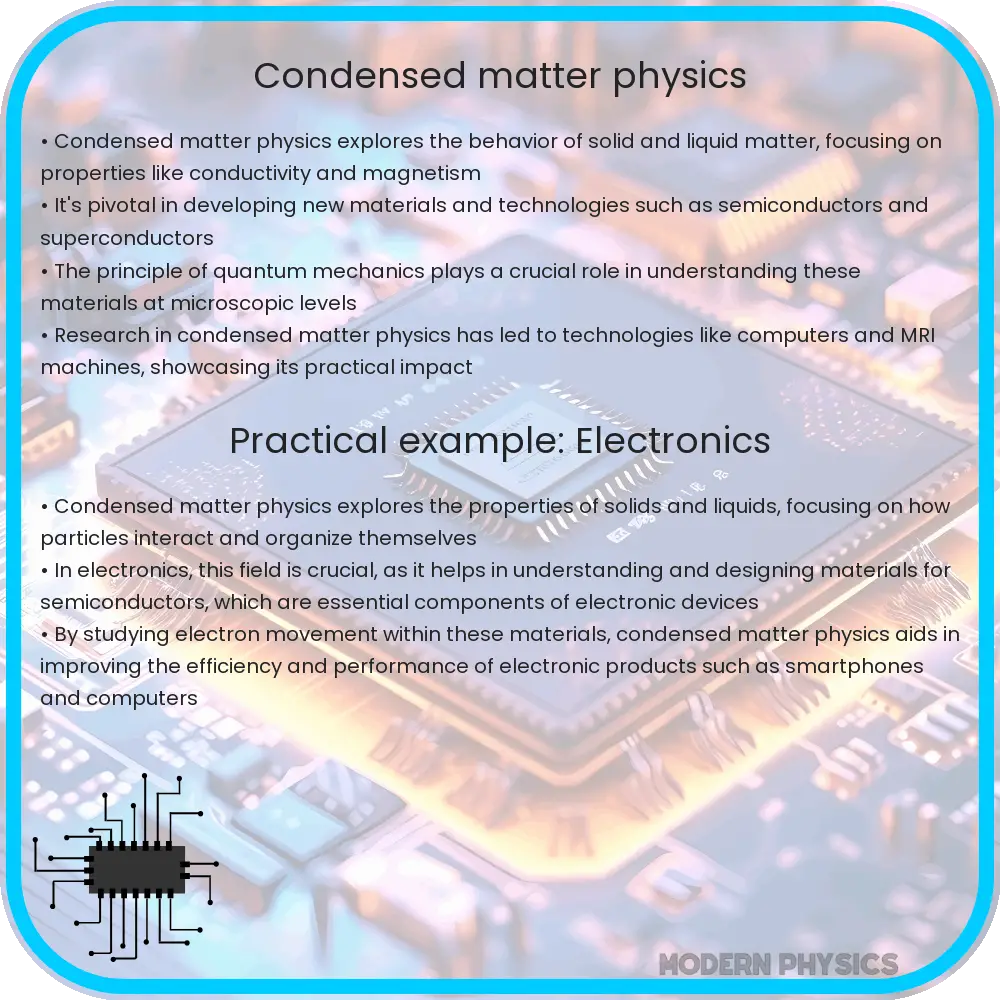Explore the cutting-edge of condensed matter physics, from quantum states and novel materials like graphene to their revolutionary tech applications.

Exploring the Quantum Realm: Condensed Matter Physics
Condensed matter physics, a branch of physics focused on the physical properties of condensed phases of matter, has been at the forefront of scientific research due to its ability to reveal new quantum states and the development of novel materials with groundbreaking applications. This field studies systems with a large number of interacting particles, leading to the emergence of new phenomena that cannot be explained by the properties of individual particles alone.
Quantum States and Phenomena in Condensed Matter
The quantum world of condensed matter physics is rich with exotic states of matter such as superconductors, superfluids, and quantum Hall fluids. These states arise from the collective behavior of electrons or atoms under extreme conditions. For instance, superconductivity, the phenomenon where a material conducts electricity without resistance below a certain temperature, showcases the quantum effects on a macroscopic scale. Similarly, superfluidity, observed in liquid helium at temperatures near absolute zero, allows it to flow without viscosity, defying the laws of classical physics.
Novel Materials: Graphene, Topological Insulators, and Beyond
In the quest for new materials with unique properties, condensed matter physics has led to the discovery of graphene, a single layer of carbon atoms arranged in a two-dimensional honeycomb lattice. Its exceptional electrical, thermal, and mechanical properties have opened avenues for applications in electronics, energy storage, and materials science. Additionally, topological insulators, materials that conduct electricity on their surface but not in their bulk, have emerged as a new frontier in condensed matter physics. These materials possess topologically protected states that are robust against impurities, making them potential candidates for quantum computing and spintronics.
Applications Transforming Technology and Industry
The implications of condensed matter physics extend far beyond the laboratory. The development of novel materials and the understanding of quantum states have practical applications in creating more efficient electronic devices, quantum computers, and sensors. Superconductors, for example, are pivotal in the fields of magnetic resonance imaging (MRI) and in the construction of particle accelerators. Similarly, the unique properties of graphene are being harnessed to revolutionize flexible electronics, transparent conductive coatings, and high-capacity batteries.
Advancements in Quantum Computing and Information Storage
The exploration of quantum states in condensed matter physics is not just limited to understanding material properties; it’s also paving the way for the next revolution in computing. Quantum computing, which exploits the principles of quantum mechanics to process information, promises to surpass the capabilities of classical computing by leaps and bounds. Materials like topological insulators and superconductors are at the heart of quantum computing research, offering pathways to qubits that are less prone to decoherence, a major hurdle in quantum computing. These advancements could lead to breakthroughs in cryptography, drug discovery, and complex system simulation.
Energy Solutions for a Sustainable Future
Condensed matter physics also plays a crucial role in addressing some of the most pressing challenges of our times—energy production and storage. Novel materials like graphene and perovskite solar cells are leading the charge in creating more efficient renewable energy sources. Graphene’s exceptional electrical conductivity and mechanical strength make it an ideal candidate for enhancing the efficiency and durability of solar panels and batteries. On the other hand, perovskites offer a cheaper and easier-to-manufacture alternative to traditional silicon-based solar cells, potentially revolutionizing solar energy production.
Challenges and Opportunities Ahead
Despite the significant progress in condensed matter physics, challenges remain. Many novel materials and quantum states require extreme conditions such as very low temperatures or high magnetic fields for their existence, limiting their practical applications. Moreover, the synthesis of these materials can be complex and costly. However, ongoing research is focused on overcoming these hurdles, aiming to bring the extraordinary properties of these quantum materials into everyday applications.
Conclusion
Condensed matter physics is a field of endless possibilities, bridging the gap between fundamental physics and practical applications. The exploration of quantum states and the discovery of novel materials are not only expanding our understanding of the universe but also revolutionizing technology and industry. From quantum computing to renewable energy, the advancements in this field promise to shape the future of our society. As researchers continue to unravel the mysteries of the quantum world, we stand on the brink of a new era of technological innovation driven by the principles of condensed matter physics.
